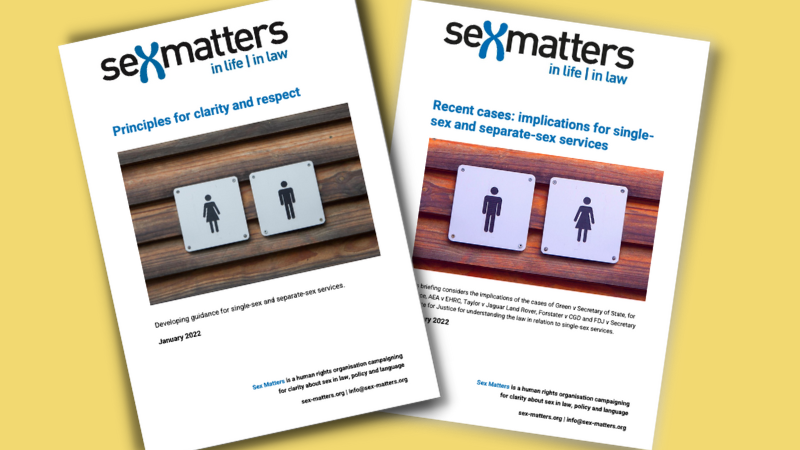What does case law say about single-sex services?

The Equality and Human Rights Commission is planning to release new guidance on single-sex services imminently.
Kishwer Falkner, Chair of the EHRC, agreed when Joanna Cherry QC MP asked her:
“Would you agree with me that all guidance issued by EHRC should be grounded in statute and case law, and that sometimes policy can be removed from statute and case law? What underpins the EHRC should be the Equality Act and the Human Rights Act?”
Joanna Cherry QC MP
Clear guidance is needed now
New, clear guidance is crucial to clear up the misunderstandings and conflicts over the Equality Act 2010.
It has been argued by trans-advocacy organisations that the Equality Act 2010 gives people with the protected characteristic of gender reassignment the right to use opposite-sex services, making it impossible to have clear rules.
For example, Stonewall told the Women and Equalities Committee:
Under the Equality Act 2010, the protected characteristic of ‘gender reassignment’ ensures most trans people can access single-sex services in line with their gender, and are not required to obtain a gender-recognition certificate (GRC), or have undergone any form of medical intervention, to be eligible for support in these services.
Stonewall
To support this, Stonewall cites the EHRC statutory Code of Practice (COP) for service providers. This contains text that suggests that trans people can only be excluded from single-sex and separate-sex services in “exceptional circumstances”, again making clear rules impossible.
In 2021 the EHRC successfully defended the Code of Practice against permission for judicial review of this guidance (AEA v EHRC). The judgment from the one-day hearing is not precedent-setting and it did not consider any real-life examples, nor relevant case law. It does not prevent the EHRC updating the code, if Parliament agrees.
Sex Matters has published two briefings to support the development of good guidance on single-sex services: one on principles and the other on cases.
What does the case law say?
The Code of Practice was written over ten years ago, and there have been several cases since then that shed light on the principles involved in single-sex services.
Some of the most important cases are not about sex directly but about age discrimination. Two Supreme Court cases from 2012, Homer v West Yorkshire Police and Seldon v Clarkson Wright and Jakes, concern the legality of rules about retirement age. They confirm that it is the fairness of a rule or policy that must be assessed against the Equality Act 2010 test of “proportionate means to a legitimate aim”, not the fairness of its application to each individual person on a case-by-case basis.
Then there have been a series of specific cases:
- Green v Secretary of State for Justice went to the High Court in 2013. It involved a transwoman prisoner who was unsuccessful in a legal challenge to be given a wig, tights and prosthetic vagina when the prison authorities said this was a security risk. While the case was not about single-sex services (Green was held in a male prison), it did address the question of comparators. This case shows that a person who identifies as the opposite sex remains legally their biological sex, unless they have obtained a gender-recognition certificate.
- Taylor v Jaguar Land Rover is an employment tribunal case that did not create a precedent, but illustrates how by allowing someone to use opposite-sex services, an employer or service provider can create a hostile environment, and risk of harassment liability.
- Forstater v CGD confirmed that the common-law definition of sex based on biology remains good law, and that the belief that sex is real, immutable and important is covered by protection against belief discrimination. People shouldn’t be harassed as employees or service users for holding this belief.
- FDJ v Secretary of State for Justice found that a policy of placing male prisoners in women’s prisons was not unlawful, based on an extensive risk-assessment process. It illustrates that the kind of risk assessment that might be used for “case by case” assessment is highly invasive and not practical outside a long-term custody situation.
Trans inclusion
The law allows service providers to offer single-sex services and does not give people the right to use opposite-sex services. It does seek to protect the right of transsexual people to participate in public life. Most parts of public life are mixed-sex, and people should not be discriminated against because they are perceived as being trans.
Encouraging a trans person to occupy a “single-sex space” with a person of the opposite sex who feels upset does not create a safe or welcoming environment for a trans person (as was seen in Taylor v Jaguar Land Rover above) or for the person who feels uncomfortable sharing with a member of the opposite sex. This is a hostile environment for all.
The EHRC argued in AEA v EHRC that if a service provider provides separate-sex services (for men and women) it should also consider whether this results in indirect discrimination towards those who feel uncomfortable about their sex.
To avoid indirect discrimination, the Equality Act 2010 requires that service providers consider whether there are alternative measures that would meet the aim without too much difficulty. The obvious alternative measure that protects the privacy and decency of all users is to also provide (and clearly signpost) alternative facilities that do not apply sex-based rules (that is, unisex facilities). This should normally avoid any “particular disadvantage” to transsexual people.
The Equality Act also does not outlaw people putting gender-identity beliefs into practice as private citizens: it protects the right of people to organise in voluntary organisations and associations on the basis of gender ideology and identity (or any other belief system or characteristic) if they wish.
